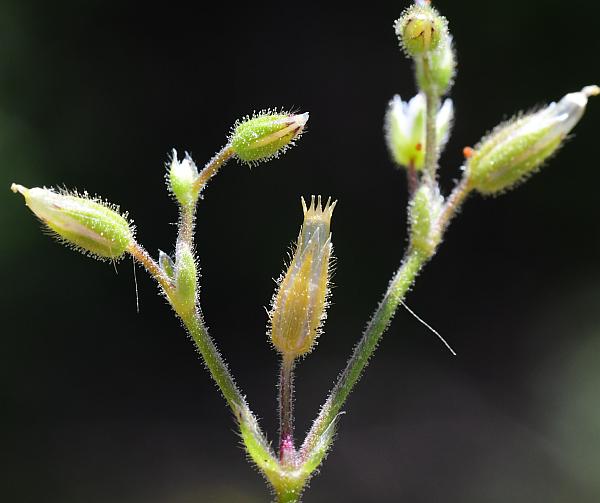Cerastium semidecandrum L.
Small Mouse-ear Chickweed

Introduced
CC = *
CW = 5
MOC = 8
© SRTurner
Cerastium semidecandrum L.Small Mouse-ear Chickweed | |
 |
Introduced CC = * CW = 5 MOC = 8 |
© SRTurner |
|
Family - Caryophyllaceae Habit - Annual forb. Stem - Ascending to erect, to 25 cm, unbranched or branched toward the tip, densely pubescent with stalked glands.
Leaves - Opposite, sessile, simple. Blades 0.3-2.0 cm long, spatulate (some basal leaves) or elliptic to broadly ovate, rounded or angled to a bluntly pointed tip, densely pubescent.
Inflorescence - Relatively open panicles, the stalks 0.3-0.9 cm long, 1-2 times as long as the sepals, erect or ascending, at fruiting often downward-angled from the base, densely pubescent with stalked glands, the bracts all with broad, thin, white to translucent margins (sometimes the entire apical half thin and white to translucent).
Flowers - Sepals 5, 3-4 mm long, lanceolate, angled to a sharply pointed tip, densely pubescent with stalked glands, these not extending past the sepal tips. Petals 5, 3-4 mm long, about as long as the sepals, notched or shallowly lobed at the tip, the veins unbranched. Stamens usually 5. Styles 5. Fruits - Capsules 4.0-7.5 mm long, 1-2 times as long as the sepals, straight or slightly curved. Seeds 0.4-0.6 mm wide, the surface indistinctly roughened or with low, rounded tubercles, brown. Dehiscent fruits with 10 apical teeth.
Flowering - April - May Habitat - Glades; also pastures, lawns, railroads, roadsides, and open, disturbed areas. Origin - Native to Eurasia. Lookalikes - Other small-flowered species of Cerastium, especially C. pumilum. Other info. - This small, weedy Cerastium resembles other members of its genus, but is relatively easily distinguished by the relatively large membranous portions of its upper bracts. Care must be taken to properly identify and evaluate the bracts, since the sepals of most species of Cerastium also have translucent margins. As of the early 2020s, this species is still relatively uncommon in Missouri and most of the U.S., but it is most likely spreading over time. Photographs taken at St. Joe State Park, St. Francois County, MO, 4-26-2020; and at Shaw Nature Reserve, Franklin County, MO, 4-18-2023 and 4-17-2025 (SRTurner). |